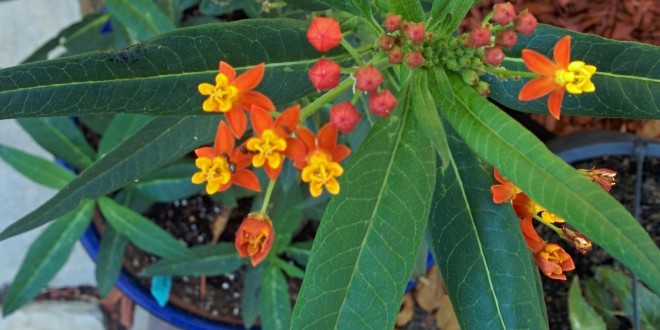Blood flowers (Aclepias curassavica) are red-orange with yellow hoods. Flowering continues throughout the summer to early autumn. Hummingbirds, butterflies and bees are attracted to the flowers. Monarch butterflies lay eggs on this plant and the resulting larvae (caterpillars) use the plant leaves as a food source. Flowers are followed by long, narrow seed pods (3-4” long) which split open when ripe releasing silky tailed seeds for dispersal by wind. Stems and leaves exude a milky sap when cut or bruised. Plants can be poisonous to livestock. Additional common names for this plant include tropical milkweed, scarlet milkweed, swallow wort, Indian root and matal. Asklepios is the Greek god of healing.
Blood flower is a tender evergreen perennial in the dogbane and milkweed family. It is native to South America, but has naturalized worldwide in many tropical and subtropical areas. It typically grows as a subshrub to 2-3’ tall on upright stems clad with pointed, opposite, lanceolate leaves (to 6” long). Leaves are medium green sometimes with white midribs. Showy flowers with five sepals and five lobes appear in rounded axillary clusters (cymes) in late spring to early summer.
Culture
Problems
Garden Uses
Common Name: blood flower
Type: Herbaceous perennial
Family: Apocynaceae
Native Range: South America
Zone: 9 to 11
Height: 2.00 to 3.00 feet
Spread: 1.50 to 2.00 feet
Bloom Time: June to October
Bloom Description: Red-orange with yellow hood
Sun: Full sun
Water: Medium
Maintenance: Low
Suggested Use: Annual
Flower: Showy
Attracts: Hummingbirds, Butterflies
Tolerate: Deer








